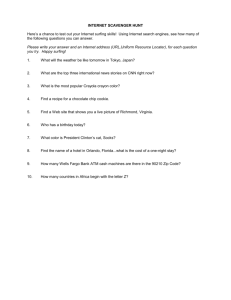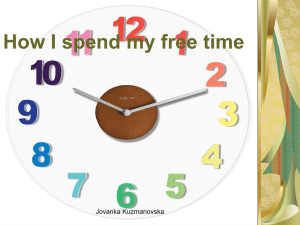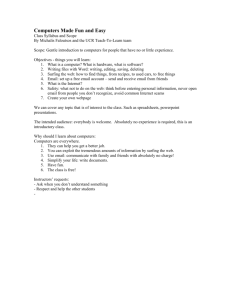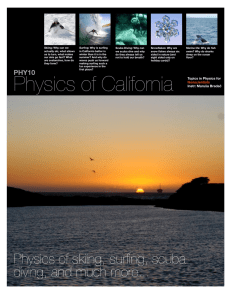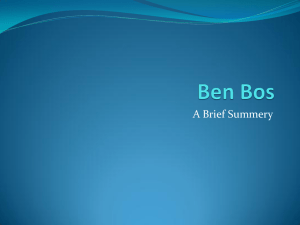MET 102 Lecture 14 Hawaiian Surfing
advertisement
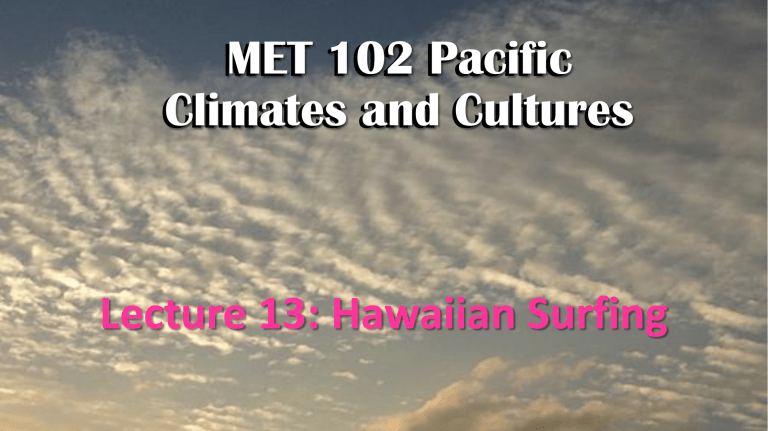
MET 102 Pacific Climates and Cultures Lecture 13: Hawaiian Surfing Discussion Questions – Clark 2011 • What are the 6 surf sports identified by Clark • • • • • • he’e nalu – Board surfing pākākā nalu – outrigger canoe surfing kaha nalu – body surfing pae po’o – bodyboarding he’e one – sand sliding he’e pu’e wai – river surfing • How did most surfers swim their boards out to the wave break? • Like modern swimmers using a kickboard! • They held on to the back of the board with it extended out in front of them instead of laying down on the board! • Some were ferried out on canoes! Discussion Questions – Clark 2011 • What are the four types of surfboards identified by Clark? • papa olo – narrow, thick, heavy boards that were rounded o the top and bottom and ranged from 14 to 16 ft long • pap kīko’o – similar to an olo, but were not as thick. They were rounded on the bottom, flat on the deck and were 9-16 ft long • papa alaia – most common, thinner, lighter, shorter, wider and only 6-9 ft long • papa li’ili’i – smallest boards, less than 6 ft long, now called paipo boards • What were ancient Hawaiian surfboards made out of? When did the transition to foam occur? • Solid wood! They were made by artisans, and there rites and ceremonies involved in selecting and cutting an appropriate tree… they typically named • 1950s foam boards arrived in CA and by the 1960 there was a foam surfboard factory in Honolulu. Quick Hawaiian Surfing Facts • Hawaiians were first discovered surfing by European explorers in 1778. • Duke Kahanamoku, an Olympic swimmer is the father of modern surfing. • Photo of Duke in Waikiki in the 1930s • Surfing has been and continues to be a major influence in popular American culture and international culture. Surfing Imagery Surfing and Canoe riding in Waikiki Hawaiian petroglyph of surfer. One of the earliest known pictures of a surfer with his board from around 1890. History of Surfing • Hawaiians may not have invented surfing • Captain James Cook observed Tahitians canoe and body surfing in 1777, the year before he arrived in Hawai’i • Surfing could have had its start anywhere in the Pacific • The Hawaiians earned the greatest renown as surfers. • Recorded Hawaiian chants as far back as the 15th century honor surfing and mention contests, competing chiefs, surfing wagers and remarkable waves. Who Surfed What? • Chiefs, men women, and youth surfed in Polynesian society in Hawaii • Chiefs rode a long, narrow, wood board called olo (18 feet long) • Common people rode short, wide, thin wood boards called alaia (6-8 feet long) • Common people also rode small belly boards called paipo. Comparison of Surfboard Shapes and Sizes Royal Surfboard Construction • Kahuna (priest) places a red kumu fish at the truck of the chosen tree • Tree was cut down and split • Prayers were offered • Kumu was places in a hole at the roots • Tree cut with adzes (bone tools) to rough surfboard dimensions • In a canoe shed final shaping was completed with coral and rough stone • The board was then sanded with water, and sharkskin. • Then, a coat of Kukui nut oil was applied with a Pandanas kernel, that was pounded to make a brush. Surfing Culture • Hawaiians’ excitement peaked in `Ikuwa (November) when winter storms brought big surf to the Islands. • If seas were calm, they enlisted a kahuna to pray and chant for surf. • In addition to being fun for the athletes, surfing was a big sport for betting amongst the spectators. • Hawaiians wagered their most important properties on contests, betting everything from pigs and poultry to canoes and their lives. Surfing Culture • Surfing was especially popular among chiefs (ali’i). • They could reserve the best resources and locations for themselves by declaring a favorite beach kapu - off limits - or by ordering the best koa or wiliwili trees cut for making their boards. • They also had greater leisure time to practice their skills • Commoners, by contrast, surfed when they could, riding the waves on anything handy, even banana trunks. Always an “addiction” • Then, as now, surfers found it hard to resist dropping everything when the waves beckoned. • Hawaiian historian Kepelino describes surfers of old: • "Expert surfers going upland to farm, if part way up perhaps they look back and see the rollers combing the beach, will leave their work ... then hurrying away home, they will pick up the board and go. All thought of work is at an end, only that of sport is left. The wife may go hungry, the children, the whole family, but the head of the house does not care. He is all for sport, that is his food." Hawaiian Surf Diction • Kai emi, naul miki – receding wave • Kai pi’i, nalu pú – high wave • kai po’i nalu ha’i – breaking wave • nalu – surf, ocean wave • nalu h’i lala – wave that breaks diagonally • pae – to mount or catch a wave • pae i ka nalu – to ride a wave into short Cooke and the Hawaiian Islands • Captain James Cook • 1728-1779 • British Navigator and Explorer • in 1778 he became the first known European to reach the Hawaiian Islands • He was impressed with Hawaiians riding waves on boards and canoes • Hawaiians were curious and unfamiliar with European concepts of ownership, and thus were shot and killed by Cook and his mean for thievery. • Hawaiians stabbed Cook in self-defense on Feb 14, 1779 Changes to Hawaiian Culture • Cooke and Early Europeans Changed the Culture • Brought metal, guns, cannons, uniforms, venereal diseases, other diseases, alcohol, and new religion • Hawaiian culture disintegrated • Between Cook’s arrival (1778) and 1890, an estimated population decrease occurred from 400,000 to 40,000 from exposure to European viruses and bacteria Changes to Hawaiian Culture • Protestant Paradigm took over • modest attire • new language • discourage casual sex, gambling and playing in the ocean • Drew Kampion writes “Surfing’s association with nakedness, sexuality, wagering, shameless exuberance, informality, ignorant joy, and freedom were counterproductive to the designs of the church fathers, who, curiously, would up owning most of the land in the islands?” Surfing Renaissance • By 1900, the Islands had become a U.S. territory • Growing number of haoles (white people or foreigners) came to Islands to visit or live • Three men got together to surf in Hawaii and resurrect surfing in 1907 • Alexander Hume ford (businessman, write) • Jack London (famous author of adventure literature) • George David Freeth (surfer) Surfing Renaissance • In 1907 in “A Royal Sport’ Suring at Waikiki” in A Woman’s Home Companion, London published a description of Freeth on a wave, “I saw him tearing in on the back of it, standing upright on his board, carelessly poised, a young god bronzed with sunburn.” • Ford reacted the Outrigger Canoe and Surfboard Club (haole organization) • Threes later predominantly Native Hawaiians created Hui Nalu • The two clubs competed often • By 1911 Outrigger Club had 1200 members • Surfboard riding was the local craze. Bringing Surfing to CA • IN 1907, Henry E. Huntington hired Irish-Hawaii Freeth to give surfing demonstrations at Redondo and Venice Beaches to promote Huntington’s Los Angeles-Redondo Beach rail service. • Thousands watched in awe • The introduction of trains and cars made California’s coast an accessible playground • Freeth is credited with introducing surfing to CA. Duke Kahanamoku • Winner of 3 Olympic gold medals in swimming. • Member of both the Swimming Hall of Fame & Surfing Hall of Fame. • Rescued 8 men in 1925 from the ocean using his surfboard. • Helped spread the popularity of surfing throughout the world. Duke Kahanamoku • Freeth enlisted “beach boys” to teach tourists how to surf in Hawaii, including Duke Kahanamoku (born in 1980), no royalty • Duke was a phenomenal waterman and athlete and remembered as a father of modern surfing • Duke won 100-meter freestyle at Olympic games in Stockholm, Sweden in 1912 • No Olympiad in 1916 due to WWI • Duke won 100-meter freestyle in Olympic games in Antwerp, Belgium in 1920 (ag 30) in 60.4 seconds Duke Kahanamoku • Revealed surfing to crowds in Atlantic City and Nassau (NY) and Corona Del Mar and other beaches in CA • Introduced surfing to Australians in 1914 at Freshwater (now Harbord) near Sydney • Demonstrated headstand and tandem surfing • Victorian values: knee-to-neck-costumes • Duke played minor roles in 7 films and 2002 stamp commemorates him Current Popular Culture References to Surfing
